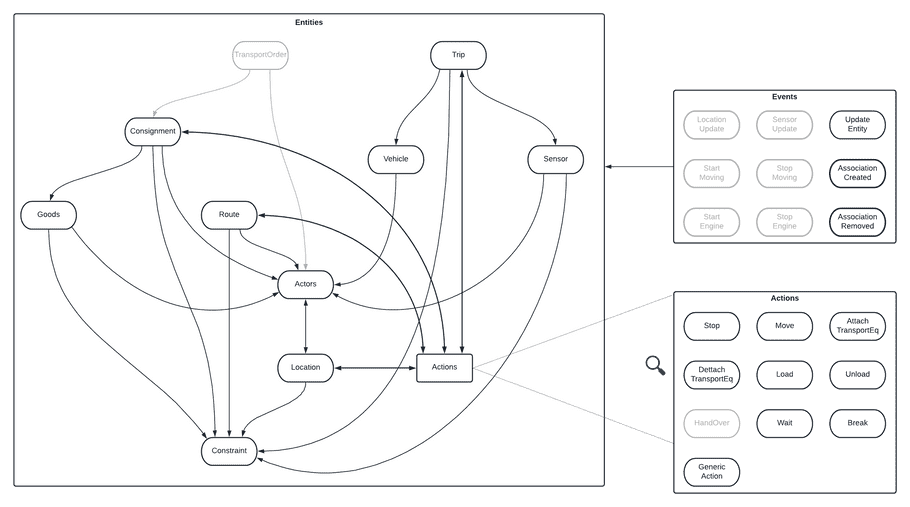Monitoring Trips
Overview
Trips model visiting multiple locations with a vehicle and doing multiple actions on and in between those locations, such as loading and unloading consignments. A single trip goes through multiple phases, each which has more information than the previous. It is possible that different parties are only involved in some of the phases, so it is not required to model each phase.
The different phases of a trip are:
- Creating a (draft) planning of a trip. This planning contains the locations that need to be visited, but might or might not know at which times these locatons will be visited. All actions in this trip are in the lifecycle planned. Other information about the trip might be gradually added, such as the vehicle and the driver that are supposed to drive this trip. Note that this is not mandatory though, if information is present it can be provided right at the start.
- Once a planning is finalized it can be driven. The vehicle and planned times are all known. At this point we might know more about the state of the world and can anticipate what will happen during the trip, such as being delayed because of a traffic jam. Continous location update and traffic events can provide real-time insight in where the vehicle is, that can serve as a basis to make predictions.
- Once all is set and done the trip is fininshed. All information is known and cannot change anymore since it is in the past. This information is useful so we can compare our original planning with what actually happened so we can make more accurate planning data in the future. It can also be used for billing, or analyzing the data to find bottlebecks and optimize the process for next trips.
General structure
Monitoring trips is a complex operation that includes almost every entity and action within OTM, and was actually the primary reason for creating OTM. Looking at the original image from the overview we can see that only the TransportOrder is not present. Everything that can be present in phase 1 is black, the additions for phase 2 are made purple, and the only addition for phase 3 is actual proof of delivery using a HandOver made red.

Since this might not give enough insight, we can also the present the hierarchy with the required rules as follows:
-
Trip
- A trip must have a unique UUID.
- A trip can contain a vehicle that is requested/planned/realized to drive the corresponding trip. Once the trip is in phase 2 the vehicle should be known.
- A trip can contain a list of involved actors, such as the carrier driving the trip of the shipper containing the goods to be transported. They are not mandatory, but recommended.
- A trip can contain constraints about the time windows between which the trip should be completed.
-
A trip
must
contain a list of actions, including at least two
stops
, and optionally a
move
between them. Since a trip has to visit at least two places to be considered a trip.
-
Stop
- A stop must contain a Location
- A stop can contain actions itself, usually load and unload actions
- The load and unload actions only require a reference to the consignments that are loaded/unloaded.
- A stop can also contain genericActions in for actions that do not have a native OTM variant yet (such as taking a break, applying maintenance, adding fuel, etc.).
- A stop can contain any other data that is present in the specification, such as a sequenceNumber , startTime , endTime , remark , etc.
- A stop can contain a time-based constraint.
- Move (this is optional), can contain the route between two stops to exactly show how to go from one place to another.
- And then again stop/move/stop, etc.
-
Stop
Example
To see examples of this profile go to the example page.